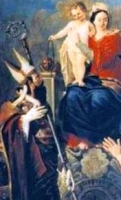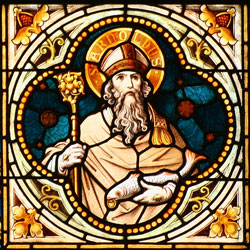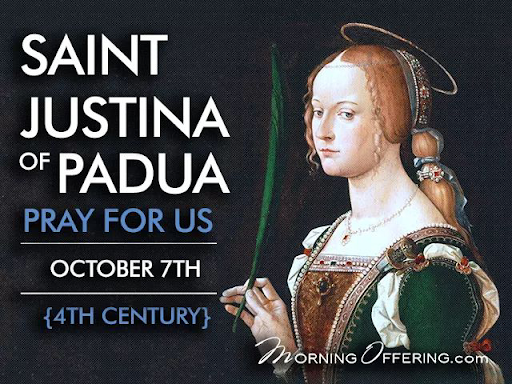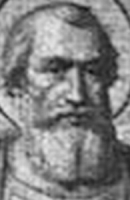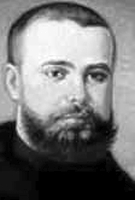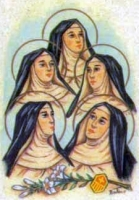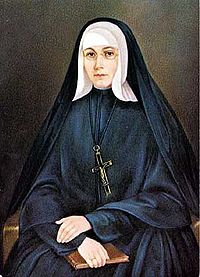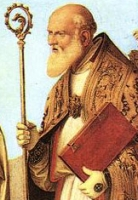Bl. Matthew de Eskandely
Feastday: October 8
Death: 1309
Martyr of China. He was one of the first missionaries to reach China during the Middle Ages. Born in Buda, Hungary, he entered the Church and set out as a missionary to the Far East. Few details have survived of his labors, but it is known that he was martyred in China.
Saint Simeon Senex
Profile
The man who, in Luke 2, picked up the Infant Jesus and gave the blessing known as the Nunc dimittis.
Readings
Now there was a man in Jerusalem whose name was Simeon. This man was righteous and devout, awaiting the consolation of Israel, and the holy Spirit was upon him. It had been revealed to him by the holy Spirit that he should not see death before he had seen the Messiah of the Lord. He came in the Spirit into the temple; and when the parents brought in the child Jesus to perform the custom of the law in regard to him, he took him into his arms and blessed God, saying:
"Now, Master, you may let your servant go in peace, according to your word, for my eyes have seen your salvation, which you prepared in sight of all the peoples, a light for revelation to the Gentiles, and glory for your people Israel."
The child's father and mother were amazed at what was said about him; and Simeon blessed them and said to Mary his mother, "Behold, this child is destined for the fall and rise of many in Israel, and to be a sign that will be contradicted (and you yourself a sword will pierce) so that the thoughts of many hearts may be revealed." – Luke 2:25-35, New American Bible
Saint Reparata
Profile
Baptized very young. Arrested and tortured for her faith at age 11 during the persecution of Decius. Thrown into a furnace to die, she sat for a while in the flames, then emerged unharmed. Rather than see this as divine intervention, the authorities simply offered her another chance to apostacize; when she refused, she was beheaded.
Born
3rd century Caesarea, Palestine
Died
• beheaded in the 3rd century
• relics translated to the Nice Cathedral in 1690
Patronage
• Florence, Italy
• Nice, France, city of
• Nice, France, diocese of
• Teano, Italy
Representation
• banner with red cross on a white background
• dove
• holding a crown and palm of martyrdom
• sitting in fire
• standing near the Blessed Virgin Mary
• with Saint Ansanus
Blessed John Adams
Additional Memorials
• 29 October as one of the Martyrs of Douai
• 22 November as one of the Martyrs of England, Scotland, and Wales
Profile
Protestant minister. Described as being of average height with dark eyes and a dark beard. Convert to Catholicism. Studied at Rheims, France. Ordained in 1579. Returned to England in March 1581 to minister to covert Catholics. He worked in Winchester and Hampshire, working primarily with the poor. Arrested for the crime of priesthood in 1584, he was exiled in 1585. He returned soon after to resume his ministry. Arrested and executed for the crime of priesthood.
Born
c.1545 in England
Died
8 October 1586 at Tyburn, London, England
Beatified
22 November 1987 by Pope John Paul II
Blessed Hugh Canefro
Also known as
• Hugh of Genoa
• Hugh of Canefri
• Hugo...
• Ugo...
Profile
Born to the Italian nobility. Fought in the Third Crusade. Member of the Knights of Malta. Assigned to the Saint John Commandery hospital in Genoa, Italy. There he sold his armour to buy clothes for nurses, and served the sick poor for 50 years.
Born
1148 at Castellazzo Bormida
Died
8 October 1233 in Genoa, Italy of natural causes
Representation
• bringing water from a rock in order to wash the clothes of the sick poor
• turning water to wine
• saving a ship in danger of sinking
Saint Thaïs the Penitent
புனிதர் தாய்ஸ்
மனம்திருந்திய விலை மகள்:
(Repentant Courtesan)
பிறப்பு: கி.பி. நான்காம் நூற்றாண்டு
இறப்பு: கி.பி. நான்காம் நூற்றாண்டு
ஏற்கும் சமயம்:
ரோமன் கத்தோலிக்க திருச்சபை
(Roman Catholic Church)
கிழக்கு மரபுவழி திருச்சபை
(Eastern Orthodox Church)
நினைவுத் திருநாள்: அக்டோபர் 8
புனிதர் தாய்ஸ், நான்காம் நூற்றாண்டில் “ரோம அலெக்சாண்ட்ரியா” (Roman Alexandria) மற்றும் “எகிப்திய பாலைவனப்” பகுதியைச் (Egyptian desert) சேர்ந்தவரும், ஒரு மனம் திருந்திய தேவதாசியுமாவார்.
சுயசரிதை :
இவர் நான்காம் நூற்றாண்டில், ரோமப் பேரரசின் கீழிருந்த எகிப்தில் வாழ்ந்ததாக அறியப்படுகின்றார். அவரது சரித்திரம், கிரேக்க திருச்சபையின் புனிதர்களின் வாழ்க்கையுடனான (Hagiographic) இலக்கியத்தில் சேர்க்கப்பட்டுள்ளது. இத்தகைய இரண்டு வாழ்க்கை வரலாற்று ஓவியங்கள் இன்னும் உள்ளன. முதலாவது, கிரேக்க மொழியிலிருந்ததாகவும், பின்னர் ஐந்தாம் நூற்றாண்டில் லத்தீனில் மொழிமாற்றம் செய்யப்பட்டதாகும். இரண்டாவது, கி.பி. 1123ம் ஆண்டு, நமக்கு இடைக்கால இலத்தீனிலிருந்து (Medieval Latin) வந்ததாகும். தாய்ஸ், (Maurolycus) மற்றும் (Greven) மூலம் கிரேக்க மறைசாட்சியாகவும் அறியப்படுகிறார். தாய்ஸ் உள்ளிட்ட எகிப்தின் பாலைவனத்தைச் சேர்ந்த புனிதர்கள் மற்றும் துறவிகளின் வாழ்க்கை வரலாறு, "பாலைவன தந்தையர்களின் வாழ்க்கை" (Vitae Patrum [Lives of the Desert Fathers]) எனும் நூலிலிருந்து பெறப்பட்டது.
தாய்ஸ், ஆரம்ப காலத்தில் அலெக்சாண்ட்ரியா பெருநகரத்தில் வாழ்ந்த அழகான, வசதி படைத்த, தேவதாசி ஆவார். இதனால், இவர் திருச்சபையின் பார்வையில் ஒரு பொதுவான பாவியாகவே பார்க்கப்பட்டார். பின்னர், கிறிஸ்தவ சமயத்தைப் பற்றி விசாரித்து அறிந்துகொண்டு மனம் மாறிய தாய்ஸ், கிறிஸ்தவ மதத்தைத் தழுவினார். அவரது மன மாற்றத்திற்கு காரணம் ஒரு துறவி என்று சொல்லப்பட்டாலும், அந்த துறவி யார் என்பது தெளிவாக எங்கும் குறிப்பிடப்படவில்லை. எகிப்திய ஆயர் “புனித பாப்னுஷியஸ்” (St. Paphnutius), “புனித பாலைவனத்து அந்தோனியாரின்” (St. Anthony of desert) சீடர் “புனித பெஸ்ஸாரியன்” (St. Bessarion) மற்றும் “நைல் டெல்ட்டாவின்” (Bishop in the Nile Delta) ஆயர் “புனித செரபியன்” (St. Serapion) ஆகிய மூன்று துறவியரில் ஒருவரே தாய்ஸ் மனம் மாற காரணமானவர்கள் என்று அறியப்படுகிறது.
அவரது மனமாற்றத்தை ஏற்றுக்கொண்ட திருச்சபை, அவரை ஒரு அருட்சகோதரிகளின் பள்ளியில் அனுமதித்தது. அங்கே அவர் இருந்த மூன்று வருடங்களும் அவர் தனிமையிலே காலம் கழித்தார். தமது பாவத்திற்காக வருந்தி, கடுமையான தவமிருந்தார். அவர் இறப்பதற்கு முன்னர், பதினைந்து நாட்களே அங்கிருந்த அருட்சசோதரிகளுடன் சேர்ந்திருந்தார் எனவும் கூறப்படுகிறது.
Also known as
Thaisis, Thaisia
Profile
Following a long life of sin, Thais converted to Christianity, brought to the faith by Saint Paphnutius of Heracleopolis in Egypt. To avoid temptation and spend the next three years in prayer, she moved into a closed cell and would only communicate with her spiritual advisors Saint Anthony the Abbot, Saint Paul the Simple and Saint Paphnutius. After that she moved into a convent, but lived only two more weeks.
Modern scholarship leans to this being a re-telling of the story of Saint Pelagia the Penitent.
Died
c.348 in Egypt of natural causes
Saint Pelagia the Penitent
புனித பெலாகியா
St. Pelagia
நினைவுத் திருநாள் : அக்டோபர் 8
பிறப்பு :14 ஆம் நூற்றாண்டு(?)
இறப்பு : 14 ஆம் நூற்றாண்டு, அந்தியோக்கியா
இவர் மார்கரேட் என்ற மற்றொரு பெயரால் அழைக்கப்பட்டார். இவர் மிகவும் அழகு வாய்ந்த பெண்ணாக திகழ்ந்தார். இவர் அந்தியோக்கியாவில் சிறந்த நடிகையாக இருந்தார். அப்போது பெலாகியா தாறுமாறான வாழ்க்கை வாழ்ந்தார். அச்சமயத்தில் ஒருநாள் அந்தியோக்கியாவில் நடித்து கொண்டிருக்கும் போது குருவாக இருந்த புனித நானூஸ் (St. Nannus) அவரைக் கடந்து சென்றார். அவரைப் பார்த்த பெலாகியாவின் மனதில் ஏதோ ஒரு நெருடல் ஏற்பட்டது. உடனே நடிக்கும் பணியை விட்டு விட்டு , நானூஸ் போதித்து கொண்டிருந்த இடத்தை நோக்கி சென்று, அவரின் மறையுரையை கேட்டார்.
அம்மறையுரையானது இவரின் மனதை மிகவும் பாதித்தது. அவர் மனமுடைந்து, நானூஸ் அவர்களிடம் மனம் நொந்து அழுது, தனது வேதனைகளை பகிர்ந்தார். பின்னர் மனமாற்றம் பெற்று, திருமுழுக்குப் பெற்று, தனது நடிகைப் பணியை விட்டு விட்டு, கடவுளுக்காக வாழ முடிவெடுத்தார்.தன்னிடமிருந்த சொத்துக்கள் அனைத்தையும் விற்று, ஏழைகளுக்கு கொடுத்தார். அந்தியோக்கியாவிலிருந்து வெளியேறி, ஆண்கள் உடுத்தும் துறவற உடையை அணிந்து வாழ்ந்தார்.
பின்னர் எருசலேமிலிருந்த ஒலிவியட் (Olivette) என்றழைக்கப்பட்ட மலையில் குகையில் வாழ்ந்த துறவிகளுடன் சேர்ந்து, தானும் ஓர் துறவியாக வாழ்ந்தார். மிகக் கடினமான ஏழ்மையை தன் வாழ்வின் மனமாற்றத்திற்குப்பின் வாழ்ந்தார். இவர் அங்கிருந்தவர்களால் " தாடியில்லா துறவி" (Beardless Monk)என்றழைக்கப்பட்டார். இவர் தன்னுடன், தன்னைப் போன்று வாழ்ந்த, சில இளம்பெண்களின் வாழ்வையும் மாற்றி, அவர்களையும் துறவற வாழ்வை வாழ அழைத்தார். இறுதியில் ஏறக்குறைய 15 இளம் பெண்களும் இவருடன் சேர்ந்து, துறவிகளாக வாழ்ந்து, தங்களின் வாழ்வின் இறுதிவரை, கடவுளுக்காக வாழ்ந்தார். தங்களின் பேச்சிலும், செயல்களிலும் இறைவனை மட்டுமே முன்வைத்து வாழ்ந்தனர்.
Also known as
• Pelagia of Antioch
• The Beardless Hermit
• Marina
Profile
Professional dancer. Attended a sermon by Saint Nonnus of Edessa during which he spoke of a stripper who worked to make herself beautiful and her dance perfect, but did nothing for the work of God. Pelagia immediately converted, confessed, was baptized, turned away from her former life, moved to Jerusalem, and lived as a hermit the rest of her days, possibly wearing men's clothes so people would leave her alone.
Patronage
actresses
Blessed Robert Dibdale
Addtional Memorial
• 4 May as one of the Martyrs of England, Scotland, and Wales
• 22 November as one of the Martyrs of England, Scotland, and Wales
• 29 October as one of the Martyrs of Douai
Profile
Priest for the apostolic vicariate of England. Martyr.
Born
c.1558 in Worcestershire, England
Died
8 October 1586 at Tyburn, London, England
Beatified
22 November 1987 by Pope John Paul II
Blessed Robert Bickerdike
Additional Memorial
22 November as one of the Martyrs of England, Scotland, and Wales
Profile
Layman in the apostolic vicariate of England during a period of official persecution. Martyr.
Born
Lowhale, Yorkshire, England
Died
23 July 1586 in York, North Yorkshire, England
Beatified
22 November 1987 by Pope John Paul II
Blessed John Lowe
Additional Memorials
• 29 October as one of the Martyrs of Douai
• 22 November as one of the Martyrs of England, Scotland, and Wales
Profile
Priest for the apostolic vicariate of England. Martyr.
Born
c.1553 in London, England
Died
8 October 1586 at Tyburn, London, England
Beatified
22 November 1987 by Pope John Paul II
Saint Benedicta of Origny-sur-Oise
Profile
Third-century Christian daughter of Mathoclus, a pagan imperial Roman senator. Missionary in Origny-sur-Oise, France. Captured, she was tortured by her father to make her abandon her faith; when that did not work, he killed her. Martyr.
Died
beheaded with an axe by her father Malthoclus in 262
Saint Amor of Aquitaine
Also known as
Amour of Aquitaine
Profile
Ninth century hermit in Maastricht, Netherlands. Founded the convent of Münsterbilsen near Liège, Belgium.
Born
Aquitaine (part of modern France)
Saint Keyna
Also known as
Keyne, Cain, Ceinwan, Ceinwen
Profile
Daughter of Saint Brychan of Brycheiniog. Fifth century anchoress in Cornwall, England where a church is dedicated to her. The town of Keynsham, Somerset, England may have been named for her.
Blessed Ragenfreda
Also known as
Ragenfrida
Profile
Nun. With her own funds she built at convent at Denain, Hainault (in modern France) and served as its abbess.
Saint Nestor of Thessalonica
Profile
Young man martyred in the persecutions of Diocletian. There is a legend of him being involved in gladatorial matches as a way to prove something about his faith, but it's apparently a late addition.
Died
early 4th century Thessalonica
Saint Felix of Como
Profile
Friend of Saint Ambrose of Milan. Worked with Saint Probinus of Como. First bishop of Como, Italy.
Born
mid-4th-century
Died
c.390 of natural causes
Saint Triduna
Also known as
Trallen, Tredwall, Triduana
Profile
Eighth century consecrated virgin who worked with Saint Regulus in Scotland. Her shrine was a centre of devotion and pilgrimage until destroyed in 1560 during the Scottish Reformation.
Saint Laurentia
Also known as
Laurenzia, Lorenza
Profile
Slave in Ancona, Italy. She brought her mistress, Saint Palatias, to Christianity. Martyred in the persecutions of Diocletian.
Died
302 in Fermo, Italy
Saint Palatias
Also known as
Palazia, Palatia
Profile
Lady of Ancona, Italy, Convert, brought to the faith by her slave, Saint Laurentia. Martyred in the persecutions of Diocletian.
Died
302 in Fermo, Italy
Saint Badilo
Profile
Monk at Vezelay, France, leading the work to re-found the abbey after Moorish and Norman raids in the 8th century. Abbot of Leuze-en-Hainaut, Belgium.
Died
c.870 of natural causes
Saint Peter of Seville
Profile
Martyr. Venerated in Seville, Spain. Many legends and tall tales grew up around him to fill in the empty parts of his biography, but none are reliable.
Saint Artemon of Laodicia
Profile
Priest. Martyred in the persecutions of Diocletian.
Died
burned to death in 305 in Laodicea, Phrygia
Saint Gratus of Chalons
Profile
Bishop of Chalons-sur-Saone, France.
Died
c.652 of natural causes
Saint Evodius of Rouen
Profile
Fifth century bishop of Rouen, France.
Saint Benedicta of Laon
Profile
Virgin-martyr in Laon, France.
Martyred in the Spanish Civil War
Thousands of people were murdered in the anti-Catholic persecutions of the Spanish Civil War from 1934 to 1939. I have pages on each of them, but in most cases I have only found very minimal information. They are available on the CatholicSaints.Info site through these links:
• Blessed Ángel Roba Osorno
• Blessed Anicet Falgueras Casellas
• Blessed Antoni Badía Andale
• Blessed Antoni Roig Alembau
• Blessed Carles Brengaret Pujol
• Blessed Casimir Riba Pi
• Blessed Feliciano Ayúcar Eraso
• Blessed Felipe Ruiz Peña
• Blessed Félix Ayúcar Eraso
• Blessed Fermín Latienda Azpilicueta
• Blessed Ferran Suñer Estrach
• Blessed Florentino Redondo Insausti
• Blessed Fortunato Ruiz Peña
• Blessed Gregorio Faci Molins
• Blessed Isidro Serrano Fabón
• Blessed Jaume Morella Bruguera
• Blessed Jeroni Messegué Ribera
• Blessed Jesús Menchón Franco
• Blessed Joan Pelfort Planell
• Blessed Joan Tubau Perelló
• Blessed José María Ruano López
• Blessed José Miguel Elola Arruti
• Blessed Josep Ambrós Dejuán
• Blessed Josep Blanch Roca
• Blessed Josep Cesari Mercadal
• Blessed Josep Mir Pons
• Blessed Juan Núñez Casado
• Blessed Julio García Galarza
• Blessed Leocadio Rodríguez Nieto
• Blessed Leoncio Pérez Gómez
• Blessed Lucio Izquierdo López
• Blessed Lucio Zudaire Armendía
• Blessed Mariano Alonso Fuente
• Blessed Néstor Vivar Valdivieso
• Blessed Nicolás Pereda Revuelta
• Blessed Nicolás Ran Goñi
• Blessed Pedro Ciordia Hernández
• Blessed Pere Sitges Puig
• Blessed Ramon Mill Arán
• Blessed Santiago Saiz Martínez
• Blessed Santos Escudero Miguel
• Blessed Segismundo Hidalgo Martínez
• Blessed Serafín Zugaldía Lacruz
• Blessed Trifón Lacunza Unzu
• Blessed Victor Gutiérrez Gómez
• Blessed Victoriano Gómez Gutiérrez
• Blessed Victoriano Martínez Martín
Also celebrated but no entry yet
• Marzio










